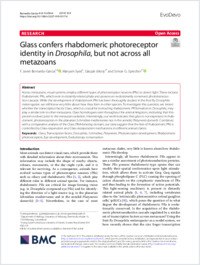Glass confers rhabdomeric photoreceptor identity in Drosophila, but not across all metazoans
- Bernardo‑Garcia, F. Javier Department of Biology, University of Fribourg, Switzerland - Department of Biochemistry and Biophysics, University of California, San Francisco, USA
- Syed, Maryam Department of Biology, University of Fribourg, Switzerland
- Jékely, Gáspár Living Systems Institute, University of Exeter, Stocker Road, Exeter, UK
- Sprecher, Simon G. Department of Biology, University of Fribourg, Switzerland
-
05.03.2019
Published in:
- EvoDevo. - 2019, vol. 10, no. 1, p. 4
English
Across metazoans, visual systems employ different types of photoreceptor neurons (PRs) to detect light. These include rhabdomeric PRs, which exist in distantly related phyla and possess an evolutionarily conserved phototransduction cascade. While the development of rhabdomeric PRs has been thoroughly studied in the fruit fly Drosophila melanogaster, we still know very little about how they form in other species. To investigate this question, we tested whether the transcription factor Glass, which is crucial for instructing rhabdomeric PR formation in Drosophila, may play a similar role in other metazoans. Glass homologues exist throughout the animal kingdom, indicating that this protein evolved prior to the metazoan radiation. Interestingly, our work indicates that glass is not expressed in rhabdomeric photoreceptors in the planarian Schmidtea mediterranea nor in the annelid Platynereis dumerilii. Combined with a comparative analysis of the Glass DNA-binding domain, our data suggest that the fate of rhabdomeric PRs is controlled by Glass-dependent and Glass-independent mechanisms in different animal clades.
- Faculty
- Faculté des sciences et de médecine
- Department
- Département de Biologie
- Language
-
- English
- Classification
- Biological sciences
- License
- License undefined
- Identifiers
-
- RERO DOC 324287
- DOI 10.1186/s13227-019-0117-6
- Persistent URL
- https://folia.unifr.ch/unifr/documents/307737
Statistics
Document views: 69
File downloads:
- spr_gcr.pdf: 127
